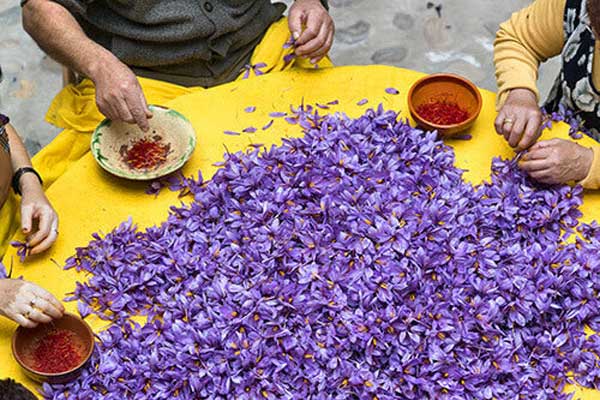Why Pick Persian Saffron Over Other Types of Saffron?
Persian saffron has, over the years, developed the reputation of being the best saffron in the world.
- Persian saffron has been produced non-sop for centuries; therefore Persian farmers have a vast knowledge of saffron and the farming process. They know what to do in the event of any mishap. Hence, Persian saffron has consistently dominated up to 95% of the global market.
- Persian saffron is less expensive when gotten directly from the source. Buying Persian saffron enables you to get high-quality product from the place where the majority of saffron is grown.
- Unlike other types of saffron which display dull brick red coloring due to age, Persian saffron threads all have crimson red with bright orange tips.
- Persian saffron has a strong and fresh aroma when compared to the musty aroma of other types of saffron. Different types of saffron most times do not separate yellow and white parts from the red stigma. They are left to add weight to the saffron. This is not the case with Persian saffron, as the white parts are thoroughly separated from the red plant parts.
- Other kinds of saffron have moister trapped inside to add weight. The stigmas are sometimes, not current season threads, but Persian saffron offers current threads of the season.
Saffron is perhaps the world's most expensive spice. For centuries, the exceptional flavor, color, and therapeutic powers of the spice have made it a coveted prize across many civilizations in Eurasia, and all over the world in the modern era. Saffron is made by drying the stigma or threads of the flowers of the Crocus sativus plant, a bulbous perennial which is part of the Crocus genus and Iridaceae family, from where it got its botanical name Crocus sativus.

To understand the painstaking effort of making saffron and why it’s so precious, you need to get a clear picture of the plant it comes from. The Crocus sativus plant can have a height of up to about 15-20cm, producing lavender-colored flowers from October to November when it is in season in autumn. The flowers have a perianth which is made up of a stalk or style which connects three stigmas or threads to the plant. The style and the red-yellow colored stigmas make up saffron that we use as a spice. No wonder saffron is the most valuable spice in the world by weight, as it takes the style and stigmas of a whopping 150,000-200,000 flowers to make 1 kilogram of this wonderful condiment spice.
Saffron thrives in cool, dry climates, and requires a fertile and well-drained, well-watered soil with abundant rainfall or irrigation facilities for a good harvest. Flowers are harvested in the early hours of the morning after which the stigmas are removed, sundried and then packed for onward delivery to the markets. The unique flavor of saffron comes from phytochemicals such as safranal and picrocrocin. The golden-yellow color of the spice is due to crocin, a naturally-occurring carotenoid chemical compound found in the plant. The tedious production process, distinct color, and flavor, as well as potent medicinal properties, make saffron the topmost ingredient in several cuisines across the globe.
Interestingly, the skill of the harvester plays an important role in the quality and strength of the saffron. If the style is too little, the flavor will be weak. And if it’s not stored properly, it quickly breaks down, and the aroma and flavor become weak.
While saffron is also made in few other places like Kashmir, Morocco, Austria, and Spain, nothing compares to the excellent flavor and breathtaking color of Persian saffron, which is why it is popularly called The Red Gold. Ounce for ounce, the saffron has been compared to the yellow metal by pundits, owing to the premium placed on the spice by royalty and nobility from ancient times up to this moment.
Saffron is not only an excellent spice, but its chemical makeup also makes it a superb dye and potent medicinal plant. It is estimated that saffron contains over 150 volatile and aromatic compounds the most important of which are carotenoids such as lycopene, alpha and beta carotenes, zeaxanthin, and the compound alpha crocin that gives the plant its dying abilities. This is why saffron is not only used for flavoring food but to also add color to non-fatty and water-based fishes in different cultures.
Saffron derives its distinctive aroma from a volatile oil called safranal while its unique flavor is the work of the bitter glucoside picrocrocin. Interestingly, picrocrocin has pesticidal and insecticidal properties, but it makes up only about four percent of the dry product and cannot do any harm to your food. Due to its organic makeup, saffron requires storage in air-tight containers as contact with atmospheric oxygen can affect its pH levels and result in a chemical imbalance that degrades the value of the spice.
Like everything in life, saffron is also graded into different categories, and this spice has its own International Standards Organization categories! The grades depend on the strength and quality, which also depend on many variables such as the age and the amount of style picked with the stigma. Categorization also depends on the place of production, but Persian saffron leads the pack.
Depending on the grade, a pound of saffron can sell from between $2000 to $11000, making it one of the most expensive spices in the world. But you don’t need a pound except you are feeding a city.


